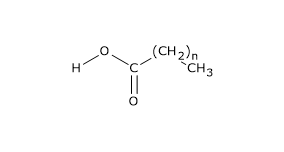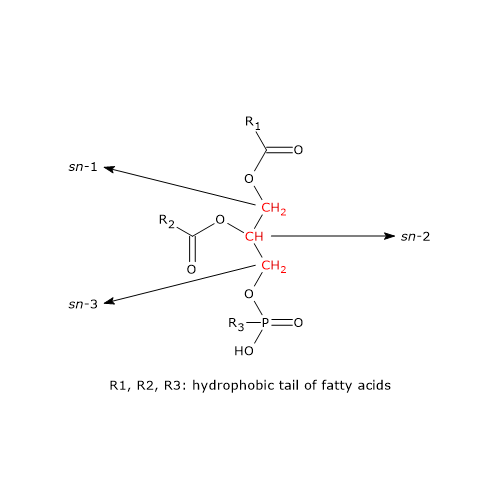Saturated fatty acids (SFAs) are fatty acids that contain no double bonds.
They have general formula R-COOH. The R- group is a straight-chain hydrocarbon of the form CH3(CH2)n with varying length ranging from short chain length, volatile liquids, to chain lengths of 30 or more carbon atoms, waxy solids, though the most common and important fatty acids, found in many different plant and animal fats, contain between 12 and 22 carbon atoms.

They are stable to oxidation as a result of the saturation of their carbon chain.
In human diet the most consumed saturated fatty acids are myristic acid, palmitic acid and stearic acid.
For a list of the most common saturated fatty acids, but also of monounsaturated and polyunsaturated fatty acids, see the page List of fatty acids.
Contents
Saturated fatty acids and chain lenght
Short chain: up to 5 carbon atoms
- Acetic acid (IUPAC name: ethanoic acid): 2 carbon atoms.
- Propionic acid (IUPAC name: propanoic acid): 3 carbon atoms.
- Butyric acid: 4 carbon atoms.
- Isobutyric acid: 4 carbon atoms.
- Valeric acid: 6 carbon atoms.
- Isovaleic acid: 6 carbon atoms.
They are volatile molecules with high water solubility, a short chain length and small molecular size.
They are present ubiquitously in the gastrointestinal tract of mammals where they are the end products of carbohydrate digestion by bacteria of the gut microbiota, particularly resistant starch and dietary fiber.
Under physiological conditions, the major short chain fatty acids produced are acetic, propionic and butyric acids; caproic acid, one of the medium-chain fatty acids, is present in small proportions except if diet contains high carbohydrate levels.
To some extent, these fatty acids can be absorbed and used by colonic enterocytes as metabolic substrates, also as an energy source. For example, butyric acid is a significant metabolic fuel for enterocytes. Futhermore, they appear to be essential for normal colonic function; again, butyric acid formed in the colon may have some anticarcinogenic action.
They can also be produced by microbial proteolysis followed by deamination.
Short chain SFA are lower in caloric value than medium chain and long chain fatty acids with the following caloric values: acetic acid, 3.5 kcal/g, propionic acid 5.0 kcal/g, butyric acid 6.0 kcal/g and caproic acid, 7.5 kcal/g.
Short chain fatty acids in certain foods
Formic, acetic and propionic acids are short chain saturated fatty acids uncommon in naturally occurring fats, while they are present in many food products.
In triacylglycerols of fat milk from cows, sheep and goats they are mainly esterified in the sn-3 position. Through the action of pancreatic and gastric lipase on triacylglycerols, that preferentially hydrolyze sn-3 esters, they are likely to be completely hydrolyzed in the lumen of the stomach and small intestine.
Butyric acid and caproic acid, together with smaller amounts of caprylic acid and capric acid plus lauric acid, medium chain fatty acids, are present in bovine milk. Butyric acid represents approximately 5-10 percent and caproic acid 3-5 percent of fatty acids in bovine milk triacylglycerols. Milk from goats and sheep also contains butyric, caproic and caprylic acids but capric acid is present in larger amounts.
Butyric and caproic acids, with medium-chain saturated fatty acids caprylic and capric acids occur in a few seeds.
Medium chain: from 6 to 12 carbon atoms
- Caproic acid: 6 carbon atoms
- Caprylic acid: 8 carbon atoms.
- Capric acid: 10 carbon atoms.
- Lauric acid: 12 carbon atoms.
They have good water solubility.
Some of them are present, together with certain short chain fatty acids, in triacylglycerols of of cow’s, goat’s and sheep’s milk fat.
Caprylic acid may be a precursor for de novo synthesis of long chain fatty acids such as myristic and palmitic acids.
Lauric acid predominates in seed fats of the Lauraceae family, from which its name derives.
Long and very long chain: from 14 atoms onwards
- Myristic acid (14 carbon atoms).
- Palmitic acid (16 carbon atoms).
- Stearic acid (18 carbon atoms).
- Arachidic acid (20 carbon atoms).
- Behenic acid (22 carbon atoms).
- Lignoceric acid (24 carbon atoms).
They have low or absent water solubility.
Myristic acid predominates in seed fats of the Myristicaceae family, from which its name derives.
Palmitic acid is the commonest saturated fatty acid in plant and animal lipids. It is found in fish oils, milk, and the fat reserves of many mammals, but is generally not present in very high quantities. With oleic acid and linoleic acid it is one of the most abundant fatty acids in triacylglycerols of adipose tissue and plasma lipoproteins.
Stearic acid is one of the most common long-chain fatty acids; it is abundant in beef fat, in cotton, coconut, palm kernel, castor beans, rapeseed, soybeans and sunflowers oils, in cocoa butter and it has been reported not to raise plasma cholesterol levels. Because stearic acid has a melting point higher than body temperature, triglycerides containing it in high amounts are poorly absorbed in humans.
Behenic acid is also poorly absorbed.
Long-chain saturated fatty acids, that is, from 20 carbon atoms onwards, are important components of only a few uncommon seed oils, and those with carbon chains up to 26 atoms long are present in small quantities in many animal tissues..
They are used by the food industry to make low-calorie lipids.
Generally, SFAs in membranes are found in sn-1 position of phospholipids, and have 16 to 18 carbon atoms, whereas unsaturated fatty acids with 18 to 20 carbon atoms are in sn-2 position.

In triacylglycerols saturated fatty acids, often long chain ones, (or monounsaturated fatty acids) tend to be in sn-1 and sn-3 positions (in sn-2 position there are polyunsaturated fatty acids).
References
- Akoh C.C. and Min D.B. “Food lipids: chemistry, nutrition, and biotechnology” 3th ed. 2008
- Arienti G. Le basi molecolari della nutrizione. Seconda edizione. Piccin, 2003
- Bender D.A. “Benders’ dictionary of nutrition and food technology”. 2006, 8th Edition. Woodhead Publishing. Oxford
- Chow Ching K. “Fatty acids in foods and their health implication” 3th ed. 2008
- Cozzani I. e Dainese E. “Biochimica degli alimenti e della nutrizione”. Piccin Editore, 2006
- Mahan L.K., Escott-Stump S.: “Krause’s foods, nutrition, and diet therapy” 10th ed. 2000
- Rosenthal M.D., Glew R.H. Mediacal biochemistry. Human metabolism in health and disease. John Wiley & Sons, Inc. 2009
- Shils M.E., Olson J.A., Shike M., Ross A.C.: “Modern nutrition in health and disease” 9th ed. 1999
- Stipanuk M.H., Caudill M.A. Biochemical, physiological, and molecular aspects of human nutrition. 3rd Edition. Elsevier health sciences, 2013 [Google eBooks]